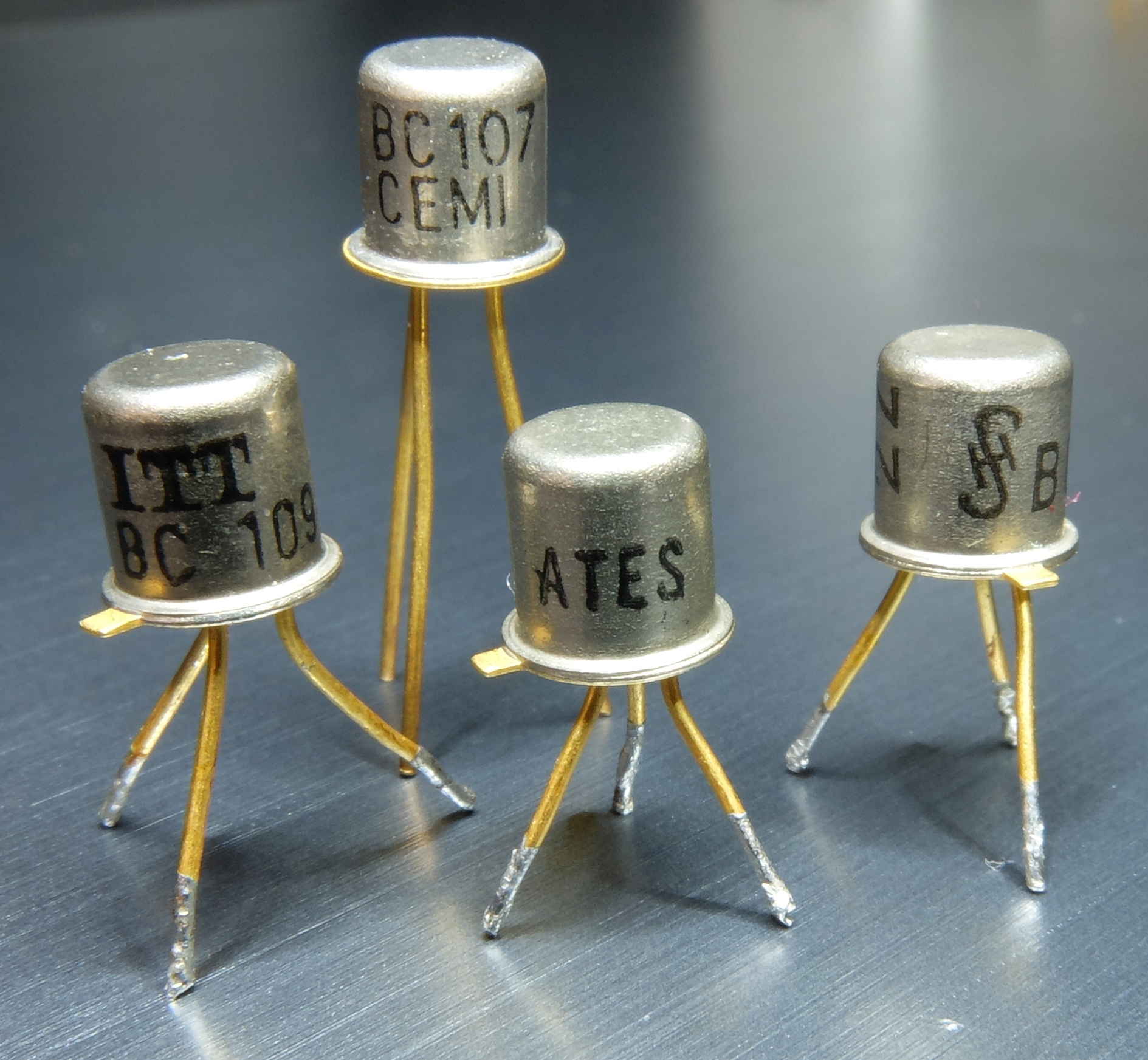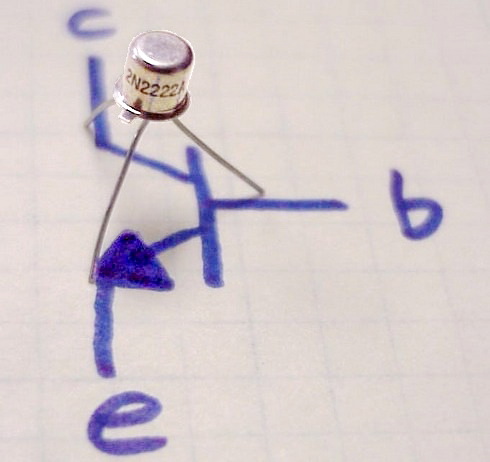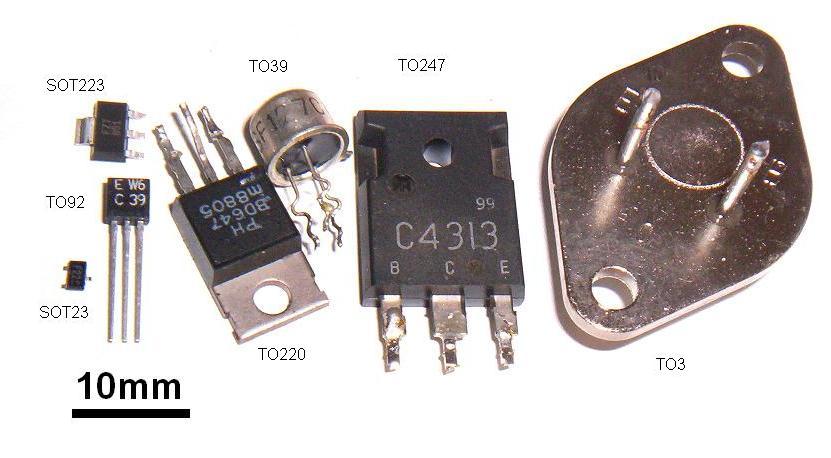|
2N3906
The 2N3906 is a commonly used PNP bipolar junction transistor intended for general purpose low-power amplifying or switching applications. It is designed for low electric current and power and medium voltage, and can operate at moderately high speeds. Overview The 2N3906 is manufactured in a plastic TO-92 case. When looking at the flat side with the leads pointed downward, the three leads emerging from the transistor are, from left to right, the emitter, base, and collector leads. The 2N3906 is specified by a collector current of 200 mA, collector-base and collector-emitter voltages of 40 V, for power dissipation of 300 mW. Its transition frequency Ft is 250 MHz, with a beta of at least 100. The complementary NPN transistor to the 2N3906 is the 2N3904. Both types were registered by Motorola Semiconductor in the mid-1960s. Part numbers The 2N3904 (NPN) and 2N3906 (PNP) are complementary transistor pairs. These transistors are available in package styles TO-92, SOT2 ... [...More Info...] [...Related Items...] OR: [Wikipedia] [Google] [Baidu] |
KT315
The KT315 is a Soviet silicon NPN bipolar junction transistor used for general-purpose low-power amplifying or switching applications, enclosed in the plastic KT-13 package. It was widely used in Soviet electronic equipment. The KT361 is a complementary ( PNP) for the KT315 transistor, so it was often paired with it in push-pull stages. KT315 and KT361 transistors became the first in the USSR, which were produced using planar technology. The characteristics achieved in the KT315 were groundbreaking in Soviet technology at that time. The process of manufacturing was much cheaper than the alloy-junction technology, and the parameters surpassed those of earlier transistor types, in particular, the unity-gain frequency was 250 MHz. The people associated with the development and mass-production launch of the KT315 were awarded the USSR State Prize for it in 1973. Application KT315 transistors were designed for use in high-, medium- and sound-frequency amplifying stages. ... [...More Info...] [...Related Items...] OR: [Wikipedia] [Google] [Baidu] |
BC548
The BC548 is a general-purpose NPN bipolar junction transistor commonly used in European and American electronic equipment. It is notably often the first type of bipolar transistor hobbyists encounter and is often featured in designs in hobby electronics magazines where a general-purpose transistor is required. The BC548 is low in cost and widely available. History and usage The BC548 is a part of a family of NPN and PNP epitaxial silicon transistors that originated with the metal-cased BC108 family of transistors. The BC548 is the modern plastic-packaged BC108; the BC548 article at the Radiomuseum website describes the BC548 as a successor to the BC238 and differing from the BC108 in only the shape of the package. Datasheets for the BC548 give specifications that are identical to, or exceed, those of the BC108, BC148 and BC238 predecessors. Thus the BC548 (or BC546 to 550) is a valid substitute in any circuit designed for the older BC108 (or BC148), which includes many Mullard an ... [...More Info...] [...Related Items...] OR: [Wikipedia] [Google] [Baidu] |
BC108 Family
The BC107, BC108 and BC109 are general-purpose low power silicon NPN bipolar junction transistors found very often in equipment and electronics books/articles from Europe, Australia and many other countries from the 1960s File:1960s montage.png, Clockwise from top left: U.S. soldiers during the Vietnam War; the Beatles led the British Invasion of the U.S. music market; a half-a-million people participate in the 1969 Woodstock Festival; Neil Armstrong and Buzz .... They were created by Philips and Mullard in 1963 and introduced in April 1966. Initially in metal (TO-18) packages, the range expanded over time to include other package types, higher voltage ratings, and a better selection of gain (hFE and hfe) groupings, as well as complementary BC548#PNP Versions of BCxxx, PNP types. Some manufacturers have specified their parts with a higher power dissipation rating (Ptot) than others. The BC548 is an example of the modern low-cost member of this family, still in a through-hol ... [...More Info...] [...Related Items...] OR: [Wikipedia] [Google] [Baidu] |
TO-92
The TO-92 is a widely used style of semiconductor package mainly used for transistors. The case is often made of epoxy or plastic, and offers compact size at a very low cost. History and origin The JEDEC TO-92 descriptor is derived from the original full name for the package: Transistor Outline Package, Case Style 92. The package is also known by the designation SOT54. By 1966 the package was being used by Motorola for their 2N3904 devices among others. Construction and orientation The case is molded around the transistor elements in two parts; the face is flat, usually bearing a machine-printed part number (some early examples had the part number printed on the top surface instead). The back is semi-circularly-shaped. A line of moulding flash from the injection-moulding process can be seen around the case. The leads protrude from the bottom of the case. When looking at the face of the transistor, the leads are commonly configured from left-to-right as the ''emitter'', ''ba ... [...More Info...] [...Related Items...] OR: [Wikipedia] [Google] [Baidu] |
2N2907
The 2N2907 is a commonly available PNP bipolar junction transistor used for general purpose low-power amplifying or switching applications. It is designed for low to medium current, low power, medium voltage, and can operate at moderately high speeds. This transistor was made by several manufacturers; Texas Instruments released a data sheet for their version of this part dated March 1973. An "A" suffix indicates a slightly higher breakdown voltage. These transistors have an enduring popularity with electronics hobbyists. Specifications It is a 0.6-ampere, 60-volt, 400-milliwatt transistor. For the 2N2907, the gain–bandwidth product under specified test conditions, or , is 200 Megahertz, which is notionally the frequency at which the current gain drops to one. Practical use of a transistor requires that it be used for frequencies much less than . At low frequencies, the current gain (beta) is at least 100. The 2N2907 is used in a variety of analog amplification and switching appli ... [...More Info...] [...Related Items...] OR: [Wikipedia] [Google] [Baidu] |
2N2222
The 2N2222 is a common NPN bipolar junction transistor (BJT) used for general purpose low-power amplifying or switching applications. It is designed for low to medium current, low power, medium voltage, and can operate at moderately high speeds. It was originally made in the TO-18 metal can as shown in the picture. The 2N2222 is considered a very common transistor, and is used as an exemplar of an NPN transistor. It is frequently used as a small-signal transistor, and it remains a small general purpose transistor of enduring popularity. The 2N2222 was part of a family of devices described by Motorola at a 1962 IRE convention. Since then it has been made by many semiconductor companies, for example, Texas Instruments.''The Transistor and Diode Data Book for Design Engineers'', Texas Instruments Incorporated, no date, TI publication number CC413 71242-73-CSS, page 4-93 Specifications The JEDEC registration of a device number ensures particular rated values will be met by all p ... [...More Info...] [...Related Items...] OR: [Wikipedia] [Google] [Baidu] |
2N3906 Transistors
N39 may refer to: * , a submarine of the Royal Netherlands Navy * Iwaidja language * Nebraska Highway 39, in the United States * Northrop N-39, an American prototype aircraft {{Letter-NumberCombDisambig ... [...More Info...] [...Related Items...] OR: [Wikipedia] [Google] [Baidu] |
Motorola
Motorola, Inc. () was an American Multinational corporation, multinational telecommunications company based in Schaumburg, Illinois, United States. After having lost $4.3 billion from 2007 to 2009, the company split into two independent public companies, Motorola Mobility and Motorola Solutions on January 4, 2011. Motorola Solutions is the legal successor to Motorola, Inc., as the reorganization was structured with Motorola Mobility being spun off. Motorola Mobility was acquired by Lenovo in 2014. Motorola designed and sold wireless network equipment such as cellular transmission base stations and signal amplifiers. Motorola's home and broadcast network products included set-top boxes, digital video recorders, and network equipment used to enable video broadcasting, computer telephony, and high-definition television. Its business and government customers consisted mainly of wireless voice and broadband systems (used to build private networks), and, public safety communicat ... [...More Info...] [...Related Items...] OR: [Wikipedia] [Google] [Baidu] |
JEDEC Standards
The JEDEC Solid State Technology Association is an independent semiconductor engineering trade organization and standardization body headquartered in Arlington County, Virginia, United States. JEDEC has over 300 members, including some of the world's largest computer companies. Its scope and past activities includes standardization of part numbers, defining an electrostatic discharge (ESD) standard, and leadership in the lead-free manufacturing transition. The origin of JEDEC traces back to 1944, when RMA (subsequently renamed EIA) and NEMA established the Joint Electron Tube Engineering Council (JETEC) to coordinate vacuum tube type numberings. In 1958, with the advent of semiconductor technology, the joint JETEC-activity of EIA and NEMA was renamed into Joint Electron Device Engineering Council. NEMA discontinued its involvement in 1979. In the fall of 1999, JEDEC became a separate trade association under the current name, but maintained an EIA alliance, until EIA ceased o ... [...More Info...] [...Related Items...] OR: [Wikipedia] [Google] [Baidu] |
ON Semiconductor
onsemi (stylized in lowercase; legally ON Semiconductor Corporation; formerly ON Semiconductor until August 5, 2021) is an American semiconductor supplier company, based in Phoenix, Arizona and ranked #483 on the 2022 ''Fortune'' 500 based on its 2021 sales. Products include power and signal management, logic, discrete, and custom devices for automotive, communications, computing, consumer, industrial, LED lighting, medical, military/aerospace and power applications. onsemi runs a network of manufacturing facilities, sales offices and design centers in North America, Europe, and the Asia Pacific regions. Based on its 2016 revenues of $3.907 billion, onsemi ranked among the worldwide top 20 semiconductor sales leaders. History onsemi was founded in 1999. The company was originally a spinoff of Motorola's Semiconductor Components Group. It continues to manufacture Motorola's discrete, standard analog, and standard logic devices. In February 2022, it was announced that BelGaN G ... [...More Info...] [...Related Items...] OR: [Wikipedia] [Google] [Baidu] |
2N3055
The 2N3055 is a silicon NPN power transistor intended for general purpose applications. It was introduced in the early 1960s by RCA using a hometaxial power transistor process, transitioned to an epitaxial base in the mid-1970s. Its numbering follows the JEDEC standard. It is a transistor type of enduring popularity. Specifications The exact performance characteristics depend on the manufacturer and date; before the move to the epitaxial base version in the mid-1970s the fT could be as low as 0.8 MHz, for example. Packaged in a TO-3 case style, it is a 15 amp, 60 volt (or more, see below), 115 watt power transistor with a β (forward current gain) of 20 to 70 at a collector current of 4 A (this may be over 100 when testing at lower currents). It often has a transition frequency of around 3.0 MHz and 6 MHz is typical for the 2N3055A; at this frequency the calculated current gain (beta) drops to 1, indicating the transistor can no longer provide useful ... [...More Info...] [...Related Items...] OR: [Wikipedia] [Google] [Baidu] |
Small-outline Transistor
A small outline transistor (SOT) is a family of small footprint, discrete surface mount transistor commonly used in consumer electronics. The most common SOT are SOT23 variations, link froamkor.com/packaging/leadframe/sot23-tsot/ref> also manufacturers offer the nearly identical thin small outline transistor (TSOT) package, where lower height is important. SOT23-3, SOT323, SOT416 The SOT23-3 package is very popular and a common package for transistors, and is also used for diodes and voltage regulators. SOT23-5, SOT353, SOT553 SOT23-6, SOT363, SOT563 SOT23-8 SOT54 SOT54 is an alternate designation for the JEDEC TO-92 package. SOT143, SOT343 SOT490 SOT89-3 The SOT89-3 electrically only has three leads (contact/pin). The wide lead (tab) is physically part of the middle lead on the other side of the package. Some call this package a SOT89-4, since it visually appears to have four leads when looking down at the part. SOT89-5 The SOT89-5 electrically onl ... [...More Info...] [...Related Items...] OR: [Wikipedia] [Google] [Baidu] |

.jpg)



